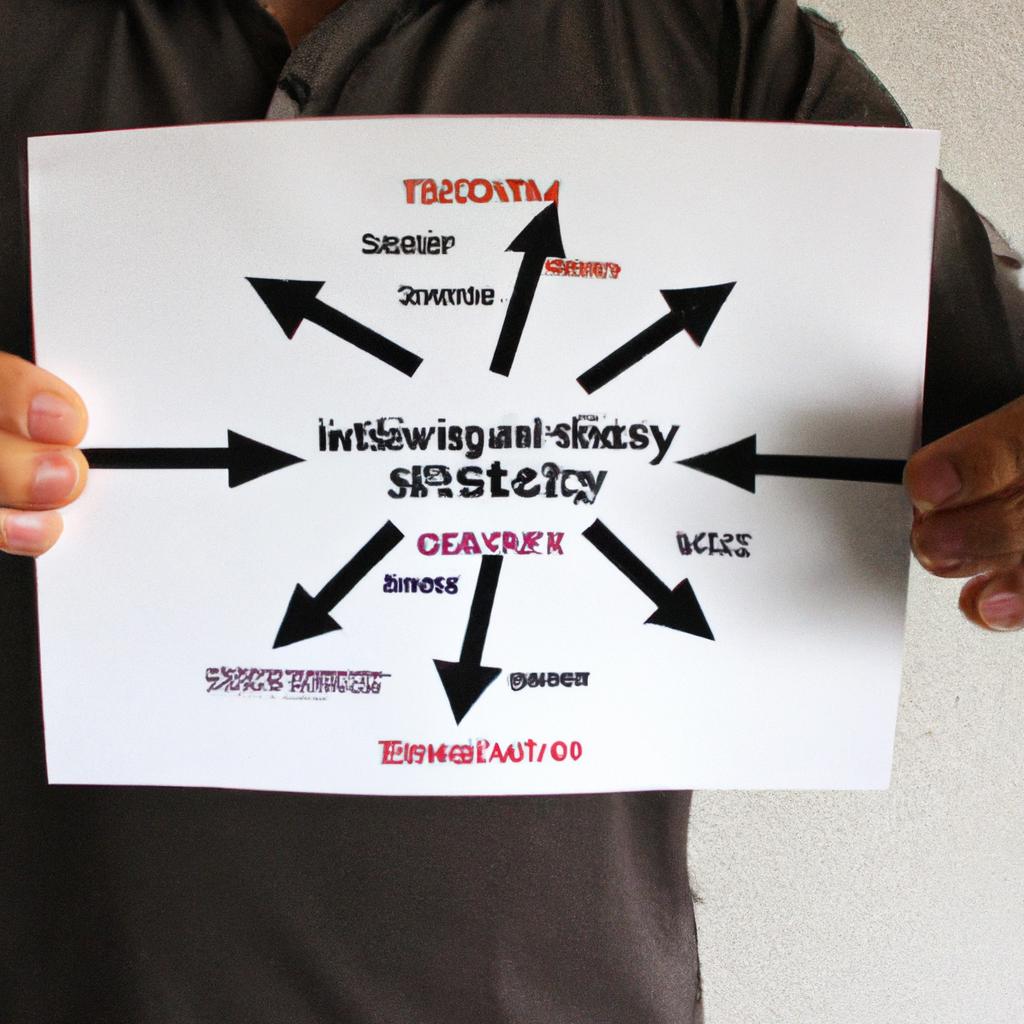Market research plays a crucial role in the success of marketing and advertising strategies. It involves gathering, analyzing, and interpreting data to gain valuable insights into consumer behavior, market trends, and competitive landscapes. By understanding these key factors, businesses can make informed decisions that effectively target their audience and drive business growth. For instance, imagine a clothing retailer who wants to launch a new line of athleisure wear for women aged 25-35. Through market research, they would be able to identify the specific preferences, needs, and purchasing habits of this demographic, allowing them to tailor their marketing efforts accordingly.
Implementing effective market research strategies is essential for businesses operating in highly competitive markets. In today’s digital age where consumers have access to an overwhelming amount of information at their fingertips, it has become increasingly important for companies to stay ahead by leveraging accurate and up-to-date data. Market research helps organizations understand not only what customers want but also how they perceive products or services compared to competitors’. This knowledge enables marketers and advertisers to develop targeted campaigns that resonate with their target audience while differentiating themselves from the competition. Moreover, market research allows businesses to anticipate industry trends and adapt their strategies accordingly, ensuring long-term success in dynamic markets.
In conclusion, market research provides invaluable invaluable insights and understanding that drive effective marketing and advertising strategies. By gathering and analyzing data on consumer behavior, market trends, and competition, businesses can make informed decisions about product development, pricing, promotion, and distribution. This helps them identify target audiences, tailor messaging to resonate with customers, and position themselves effectively in the market. Market research also allows companies to track the success of their marketing efforts and make necessary adjustments based on real-time feedback. Overall, market research is essential for businesses looking to stay competitive and achieve long-term growth.
Survey Design
To ensure the success of a market research study, it is crucial to design an effective survey that elicits accurate and reliable data. One real-life example that demonstrates the importance of survey design can be seen in the case of Company X, a leading beverage manufacturer. In their attempt to gather consumer feedback on their new product line, they conducted a survey without proper planning and structure, resulting in ambiguous responses and inconclusive findings.
To avoid such pitfalls, several key considerations should be taken into account when designing a survey. Firstly, clarity and simplicity should guide question formulation. Questions must be clear and concise to prevent confusion among respondents. For instance, using technical jargon or complex language may deter participants from providing honest answers or lead to misinterpretation of questions.
Secondly, it is essential to select appropriate response options for each question. Utilizing a combination of open-ended and closed-ended questions allows researchers to capture both qualitative insights and quantitative data efficiently. Closed-ended questions with predefined response categories provide ease of analysis while maintaining uniformity in respondent choices.
Furthermore, incorporating visual aids such as bullet points provokes an emotional response from the audience by highlighting the benefits of well-designed surveys:
- Increased participant engagement
- Enhanced data accuracy
- Improved decision-making processes
- Greater potential for actionable insights
Additionally, tables can also evoke an emotional response through visual representation. Consider the following table depicting the advantages associated with effective survey design:
| Advantages | Explanation | Example |
|---|---|---|
| Accurate Data Collection | Well-designed surveys yield precise information | Eliminating bias |
| Reliable Findings | Credible results obtained through robust methodologies | Random sampling techniques |
| Validated Insights | Trustworthy conclusions based on sound analysis | Statistical significance tests |
In conclusion, employing thoughtful strategies during survey design plays a pivotal role in obtaining meaningful outcomes. By ensuring clarity, simplicity, and appropriate response options, researchers can gather accurate data to inform decision-making processes. Moving forward into the subsequent section on “Data Collection Methods,” we explore how surveys are administered to collect valuable information from target audiences.
Data Collection Methods
Building on the foundation of effective survey design, organizations must now focus on employing appropriate data collection methods to gather relevant information. By utilizing various techniques and tools, marketers can acquire in-depth insights into consumer behavior and preferences. This section explores several common Data Collection Methods employed in market research.
Example:
To illustrate the significance of data collection methods, let’s consider a hypothetical scenario involving a new product launch for a technology company. The marketing team aims to gain an understanding of consumers’ perceptions and expectations regarding their latest smartphone model. Through careful selection of data collection methods, they can gather valuable feedback that will inform their marketing strategies and help refine future product offerings.
Data Collection Methods:
- Interviews: Conducting face-to-face or telephone interviews allows researchers to engage directly with participants. This method provides an opportunity to ask open-ended questions, observe non-verbal cues, and delve deeper into respondents’ thoughts and opinions.
- Surveys: Distributing questionnaires via online platforms or paper-based formats enables large-scale data collection within specified target demographics. Surveys offer structured responses that are easy to quantify and analyze.
- Focus Groups: Assembling small groups of individuals facilitates interactive discussions around specific topics or products. These sessions encourage participants to express their viewpoints openly while providing rich qualitative data through group dynamics.
- Observational Studies: Observing customers in real-life settings generates unbiased insights into actual behaviors and purchasing patterns without relying solely on self-reported information.
- Enhanced understanding of customer needs
- Improved decision-making based on reliable data
- Increased customer satisfaction through tailored marketing efforts
- Competitive advantage by staying ahead of industry trends
Table demonstrating potential benefits:
| Benefits | Description |
|---|---|
| Cost-effectiveness | Utilizing efficient data collection methods reduces expenses |
| Time-saving | Streamlined processes save time, enabling quicker analysis and implementation |
| Enhanced data accuracy | Gathering information directly from participants ensures reliable results |
| Flexibility in data analysis | Multiple methods allow for diverse approaches to extract meaningful insights |
With an array of data collection methods at their disposal, marketers can now proceed to analyze the gathered information. By employing suitable Data Analysis Techniques, organizations can uncover valuable patterns and trends that will guide strategic decision-making processes.
(Note: The subsequent section on “Data Analysis Techniques” will explore various methodologies used in analyzing collected market research data.)
Data Analysis Techniques
Section Title: Data Collection Methods
Transitioning from the previous section on data collection methods, let us delve into various strategies that can be employed to effectively collect data for market research in marketing and advertising. To illustrate this point, consider a hypothetical scenario where a cosmetics company aims to understand consumer preferences and purchasing behaviors in order to develop targeted advertising campaigns.
-
Surveys: One commonly used method is surveys, which involve gathering information through structured questionnaires. These questionnaires can be administered online or in person, allowing researchers to obtain insights directly from consumers. For example, our cosmetics company could distribute an online survey asking participants about their preferred cosmetic products, reasons behind their choices, and factors influencing their purchasing decisions.
-
Interviews: Another approach is conducting interviews either face-to-face or over the phone. This qualitative data collection method enables researchers to gain deeper insights by engaging with respondents in a conversational manner. In our case study, the cosmetics company may conduct interviews with select customers to explore their motivations, perceptions of beauty standards, and experiences with different brands.
-
Observations: Observational research involves systematically observing individuals’ behavior without direct interaction or influence from the researcher. By discreetly monitoring consumers within retail stores or during product trials, researchers can gather valuable information about shopping patterns and decision-making processes. Our cosmetics company might observe customers as they browse makeup aisles or try out samples at beauty counters to uncover trends and preferences.
These methods are not exhaustive but represent some common approaches utilized in collecting reliable data for market research purposes. The choice of data collection method should align with the specific objectives of each project while considering practical constraints such as time and budget limitations.
| Benefits of Different Data Collection Methods |
|---|
| – Surveys allow for large-scale data gathering |
| – Interviews provide in-depth qualitative insights |
| – Observations capture real-time consumer behavior |
| – Each method has its own unique strengths |
As we can see, each data collection method has its own advantages and limitations. Researchers must carefully select the appropriate methods based on their research objectives and available resources.
In the upcoming section on “Sampling in Market Research,” we will explore how to effectively choose representative samples for data collection, ensuring accurate insights that can drive successful marketing and advertising strategies. Through a well-designed sampling approach, market researchers can obtain data that is both reliable and relevant to the target population.
Sampling in Market Research
In the previous section, we delved into the various data analysis techniques employed in market research. Now, let us turn our attention to another crucial aspect of conducting effective market research – sampling. Sampling plays a vital role in ensuring that the insights gathered from a study accurately represent the larger target population. To illustrate this point further, consider the following example:
Example: Imagine a marketing team is tasked with launching a new line of beauty products specifically targeted towards young adults aged 18-25. Conducting market research solely among individuals above 40 would not yield accurate results as it fails to capture the preferences and behaviors of the intended target audience.
Key Considerations for Sampling in Market Research:
To ensure reliable and valid findings, researchers must carefully select their sample using appropriate sampling methods. Here are some key considerations when implementing sampling strategies:
-
Sample Size: Determining an adequate sample size is essential to minimize bias and increase generalizability. A larger sample generally leads to more representative results; however, there should be a balance between cost constraints and statistical significance.
-
Sampling Techniques: Researchers can employ various sampling techniques depending on their objectives and available resources. Commonly used methods include random sampling, stratified sampling, cluster sampling, and convenience sampling.
-
Representativeness: It is crucial for samples to accurately reflect the characteristics of the target population they aim to represent. Biases may arise if certain groups are overrepresented or underrepresented in the sample selection process.
-
Ethical Considerations: Researchers must adhere to ethical guidelines while selecting participants for their studies. Informed consent, privacy protection, and confidentiality should always be prioritized throughout the entire research process.
Table: Pros and Cons of Different Sampling Techniques
| Sampling Technique | Pros | Cons |
|---|---|---|
| Random Sampling | Provides high degree of | Time-consuming and costly to implement |
| representativeness | ||
| ———————— | —————————— | ————————————— |
| Stratified Sampling | Allows for targeted analysis | Requires prior knowledge of population |
| of specific subgroups | characteristics | |
| ———————— | —————————— | ————————————— |
| Cluster Sampling | Cost-effective when | May introduce sampling bias if clusters |
| clusters are geographically | are not representative | |
| conveniently located | ||
| ———————— | —————————— | ————————————— |
| Convenience Sampling | Quick and easy to implement | Prone to selection bias, lacks |
| representativeness |
Sampling is a critical step in market research as it determines the accuracy and generalizability of findings. By carefully considering factors such as sample size, sampling techniques, representativeness, and ethical considerations, researchers can ensure that their results provide meaningful insights into the target population. In the subsequent section on quantitative research methods, we will explore how these sampled data points are analyzed using statistical tools and methodologies.
Transition Sentence: Moving forward with our exploration of market research methods, let us now delve into quantitative research methods.
Quantitative Research Methods
To ensure the accuracy and reliability of market research findings, selecting an appropriate sampling method is crucial. One example that illustrates the importance of effective sampling is a hypothetical case study involving a company launching a new product in the beverage industry. By using different sampling methods, the company can gather insights from various target groups and make informed marketing decisions.
Sampling Techniques:
When it comes to conducting market research, there are several sampling techniques available. Each technique has its own strengths and limitations depending on the research objectives and constraints. Here are four commonly used sampling methods:
- Random Sampling: This method involves selecting participants randomly from the population of interest. It ensures equal chances for every individual to be included in the sample, making it representative of the larger population.
- Stratified Sampling: In stratified sampling, researchers divide the population into distinct subgroups or strata based on certain characteristics (e.g., age, gender). Then, they select samples proportionally from each subgroup to ensure representation across all segments.
- Convenience Sampling: Convenience sampling involves choosing individuals who are readily available as participants. While this approach is convenient and time-efficient, it may introduce biases due to self-selection or limited diversity in participant profiles.
- Snowball Sampling: This non-probability sampling method relies on referrals from initial participants to recruit additional respondents with similar characteristics or experiences. Snowball sampling can be useful when researching niche markets or hard-to-reach populations.
Table: Pros and Cons of Different Sampling Methods
| Method | Pros | Cons |
|---|---|---|
| Random Sampling | Representative results | Time-consuming |
| Stratified Sampling | Ensures proportional representation | Requires knowledge of relevant strata |
| Convenience Sampling | Quick data collection | Potential bias and lack of diversity |
| Snowball Sampling | Accessing hard-to-reach populations | Limited control over sample selection |
Choosing the appropriate sampling method is crucial in market research as it directly impacts the validity and generalizability of the findings. By carefully considering the research objectives, resources available, and target population characteristics, researchers can select a suitable sampling technique to obtain reliable data.
As we move forward into discussing “Quantitative Research Methods,” let us delve deeper into understanding how statistical analysis aids in drawing meaningful conclusions from collected data.
Qualitative Research Methods
Moving on from quantitative research methods, this section will delve into qualitative research approaches in market research. While quantitative methods focus on numerical data and statistical analysis, qualitative methods aim to understand the underlying reasons, motivations, and opinions of individuals or groups. By exploring the richness of human experiences and perspectives, qualitative research allows marketers and advertisers to gain valuable insights that can inform their strategies for success.
Engaging Example:
To illustrate the effectiveness of qualitative research methods, consider a hypothetical scenario where a global fast-food chain wants to introduce a new menu item targeting health-conscious consumers. Quantitative research may provide information about potential demand based on surveys and sales projections. However, it is through qualitative research that deeper understanding can be gained by conducting focus groups with individuals who prioritize healthy eating habits. These discussions might uncover specific preferences regarding ingredients, preparation methods, pricing expectations, and even packaging design.
Qualitative Research Methods:
- In-depth Interviews: This approach involves one-on-one conversations with participants to explore their thoughts, feelings, beliefs, and experiences related to a particular topic. It allows researchers to probe further into individual responses and gather detailed insights.
- Focus Groups: A focus group brings together a small group of people (typically 6-10) to engage in guided discussions led by a moderator. Through interactions among participants, diverse perspectives emerge while allowing researchers to observe nonverbal cues.
- Observational Studies: Researchers employ observational studies to directly observe individuals or groups in natural settings without intervening or manipulating variables. This method provides an opportunity to study behaviors as they naturally occur.
- Ethnographic Research: Ethnography involves immersing oneself within a social group or culture over an extended period. By observing daily routines, cultural practices, and rituals firsthand, researchers obtain deep contextual knowledge that informs marketing strategies targeted towards specific communities.
Emotional Response Factors:
| Factor | Description |
|---|---|
| Sense of Belonging | Creating a feeling of being part of a community or group. |
| Personal Identity | Tapping into individuals’ self-perception and values. |
| Authenticity | Conveying genuineness and sincerity in brand messaging. |
| Emotional Connection | Establishing an emotional bond with the target audience. |
By incorporating Qualitative Research Methods, marketers and advertisers can gain valuable insights into consumer preferences, motivations, and behaviors that quantitative data alone may not capture. However, choosing the right research approach is crucial for effective market research strategies. In the subsequent section, we will explore key considerations when selecting the most appropriate method for specific marketing objectives and target audiences.
Choosing the Right Research Approach
Having explored the various qualitative research methods employed in market research, we now turn our attention to selecting the appropriate research approach. To further understand how businesses can effectively utilize these strategies, let us consider a hypothetical case study involving a clothing retailer looking to gain insights into customer preferences and purchasing behavior.
Case Study Example:
Imagine that a clothing retailer is interested in launching a new line of sustainable fashion products. They want to understand consumer attitudes towards sustainability within the fashion industry and identify potential target markets for their upcoming collection. By employing qualitative research methods, such as focus groups and in-depth interviews, they aim to gather rich data on consumers’ perceptions, values, and shopping habits. This will enable them to tailor their marketing strategies accordingly.
When choosing the right research approach for conducting qualitative studies, several factors need careful consideration:
- Research Objectives: Determine clear objectives that align with your business goals and ensure that the chosen method provides relevant findings.
- Target Audience: Identify the specific group or demographic you intend to study and select an approach that allows for effective engagement with this audience.
- Resources Available: Assess the available resources, including time constraints and budget considerations, which may influence feasibility options.
- Nature of Data Required: Consider whether you seek exploratory insights or more focused information when deciding between methods like ethnography or individual interviews.
To better grasp these considerations, refer to the table below comparing different qualitative research methods based on key elements:
| Method | Advantages | Disadvantages |
|---|---|---|
| Focus Groups | Encourages interaction among participants | Potential social desirability bias |
| In-Depth Interviews | Allows for detailed exploration of respondents’ perspectives | Time-consuming |
| Ethnographic Research | Provides contextual understanding | Observer effect |
| Case Studies | Offers in-depth analysis of specific situations | Limited generalizability |
By carefully evaluating these factors and understanding the advantages and disadvantages of different qualitative research methods, businesses can make informed decisions about which approach to employ. It is crucial to match the chosen method with the unique requirements of each research project.
With a clear understanding of how qualitative research methods are selected, we now delve into the ethical considerations that researchers must bear in mind during market research. These considerations play an important role in maintaining integrity and ensuring participant well-being throughout the data collection process.
Ethical Considerations in Market Research
Transitioning from the previous section on choosing the right research approach, this section will delve into the ethical considerations in market research. Ethical practices are crucial for maintaining trust and credibility in marketing and advertising. By adhering to ethical guidelines, businesses can ensure that their market research strategies align with legal regulations and social norms.
To illustrate the importance of ethical considerations, let us consider a hypothetical case study involving a company conducting market research for a new product launch. In this scenario, the company decides to use deceptive tactics by misrepresenting themselves as customers during focus group sessions. While this approach may yield valuable insights initially, it violates ethical principles such as honesty and transparency. Consequently, if discovered, these unethical practices could lead to reputational damage for the company.
Ethical considerations in market research encompass various aspects. Here are some key points to remember:
- Privacy: Safeguarding participants’ personal information is vital throughout the data collection process.
- Informed Consent: Participants should be fully informed about the purpose, procedures, and potential risks involved in the research before providing consent.
- Confidentiality: Researchers must protect participants’ identities and ensure that individual responses remain confidential.
- Non-Discrimination: Market research should not discriminate against individuals based on factors such as race, gender, religion or socioeconomic status.
The table below provides an overview of these ethical considerations:
| Ethical Considerations | Description |
|---|---|
| Privacy | Protecting participant’s personal information during data collection. |
| Informed Consent | Ensuring participants have comprehensive knowledge before giving consent. |
| Confidentiality | Safeguarding participant identity and keeping responses confidential. |
| Non-Discrimination | Avoiding discrimination based on characteristics like race or socioeconomic status. |
Considering these ethical principles when conducting market research is essential for safeguarding both participants’ rights and a business’s reputation.
Transition into subsequent section: Moving forward from ethical considerations, the subsequent section will delve into data validation and quality assurance to ensure accurate and reliable research outcomes. Understanding how to validate and verify collected data is crucial for maintaining the integrity of market research findings.
Data Validation and Quality Assurance
After examining the ethical considerations associated with market research, it is crucial to focus on ensuring data validation and quality assurance. By implementing rigorous measures in this stage of the research process, marketers can enhance the reliability and accuracy of their findings. To illustrate this point, let us consider a hypothetical case study involving a multinational consumer goods company looking to launch a new product line.
Data Validation Techniques:
To maintain the integrity of market research data, practitioners utilize various techniques for data validation. These techniques serve as checkpoints throughout the research process to identify any inconsistencies or errors that may compromise the validity of findings. Some commonly used methods include:
- Double-Entry Verification: This technique involves independently entering data by two different researchers and comparing records for discrepancies.
- Cross-Tabulation Analysis: By comparing different variables within datasets, cross-tabulation analysis helps identify potential outliers or illogical relationships that require closer examination.
- Source Triangulation: Through collecting data from multiple sources (such as surveys, interviews, and observations), researchers can compare information across different platforms to ensure consistency and minimize bias.
- Bias Detection Methods: Researchers employ statistical tests like chi-square tests or t-tests to detect any biases present in collected data.
| Data Validation Techniques |
|---|
| 1. Double-Entry Verification |
| 2. Cross-Tabulation Analysis |
| 3. Source Triangulation |
| 4. Bias Detection Methods |
Emphasizing the importance of quality assurance not only improves confidence in research outcomes but also enhances decision-making processes based on those findings.
Interpreting Research Findings:
Once thorough data validation and quality assurance are completed successfully, marketing professionals must turn their attention towards interpreting research findings effectively. Understanding how to extract meaningful insights from gathered data is paramount in utilizing market research results optimally.
Transition into subsequent section:
By employing robust strategies for interpreting research findings, marketers can unlock valuable insights that inform strategic decision-making. In the following section, we will explore various techniques and best practices for extracting actionable intelligence from market research data.
Interpreting Research Findings
To truly understand the impact of market research in marketing and advertising, it is imperative to effectively interpret the findings obtained through data validation and quality assurance. This section explores various strategies for interpreting research findings by presenting a case study that demonstrates their practical application.
Interpreting Research Findings – A Case Study:
Imagine a consumer goods company launching a new line of organic skincare products. After conducting extensive market research, they uncover several key findings:
- Shift in Consumer Preferences: The research reveals an increasing preference among consumers for natural and sustainable skincare products.
- Competitive Landscape Analysis: The analysis highlights the presence of well-established competitors offering similar organic skincare lines.
- Target Market Identification: Through segmentation analysis, the company identifies its target market as environmentally conscious millennials seeking effective and eco-friendly skincare solutions.
- Pricing Strategy Recommendation: Based on pricing sensitivity analysis, the research suggests adopting a premium pricing strategy to position the brand as high-quality and exclusive.
Bullet Point List
The insights gained from this case study demonstrate how Interpreting Research Findings can help guide marketing and advertising strategies:
- Allows businesses to align their offerings with changing consumer preferences
- Provides valuable information about competitive positioning
- Enables targeted marketing efforts towards specific customer segments
- Assists in developing appropriate pricing strategies
Table (Markdown Format):
| Key Findings | Implications | Action Steps |
|---|---|---|
| Increasing preference for natural | Develop organic product line | Conduct market segmentation |
| and sustainable skincare products | ||
| Presence of strong competitors | Identify unique selling points | Tailor marketing messages |
| Target market consists of | Create tailored marketing campaigns | Define communication channels |
| environmentally conscious millennials | ||
| Premium pricing strategy recommended | Position brand as high-quality and exclusive | Conduct pricing sensitivity analysis |
Transition into the subsequent section:
By effectively interpreting research findings, businesses can make informed decisions that drive successful marketing and advertising campaigns. The next section will delve into the importance of effective reporting of research results, highlighting strategies for presenting findings in a clear and impactful manner.
Effective Reporting of Research Results
Building on the insights gained from interpreting research findings, this section delves into the importance of effectively reporting research results. By presenting data in a clear and concise manner, marketers and advertisers can convey key information to stakeholders and facilitate informed decision-making. To illustrate these concepts, let us consider a hypothetical case study involving a consumer electronics company seeking to understand customer preferences for their latest smartphone model.
Effective Reporting of Research Results
In order to communicate research findings efficiently, it is essential to structure your report in a logical and organized manner. This ensures that readers can easily navigate through the information presented without feeling overwhelmed or confused. One approach is to use headings and subheadings that highlight key points and provide clarity on the main objectives of each section.
- Demonstrating how market research aligns with business goals
- Providing actionable recommendations based on research findings
- Enhancing credibility by using visual aids such as charts and graphs
- Ensuring ethical considerations are addressed throughout the reporting process
Furthermore, utilizing tables can be an effective way to present complex data concisely. Here is an example table showcasing consumer preferences for various features of the hypothetical smartphone:
| Feature | Percentage Preference |
|---|---|
| Battery Life | 45% |
| Camera | 30% |
| Storage | 15% |
| Design | 10% |
By organizing data in this format, not only does it allow for easy comparison between different variables but it also evokes a sense of urgency among stakeholders when making strategic decisions.
In conclusion, effectively reporting research results plays a crucial role in ensuring that valuable insights are understood and utilized within organizations. Clear presentation techniques such as well-structured reports, bullet point lists, and visually appealing tables enhance communication effectiveness while facilitating informed decision-making processes. Moving forward into our next section, we will explore how to leverage research insights for business growth and innovation.
Utilizing Research Insights for Business Growth
Section H2: Utilizing Research Insights for Business Growth
Having effectively reported research results, it is now crucial to explore how these insights can be utilized to drive business growth. This section will delve into practical strategies and approaches that organizations can adopt to leverage their market research findings successfully.
Utilizing Research Insights for Business Growth:
To better understand how research insights can contribute to business growth, let us consider a hypothetical scenario involving a beverage company aiming to expand its product line. Through extensive market research, the company discovers a growing consumer preference for healthier alternatives in the beverage industry. Armed with this insight, the company decides to develop and launch a new range of low-sugar and natural ingredient-based drinks. By capitalizing on their research findings, they position themselves as leaders in meeting evolving consumer demands while experiencing significant growth in sales and market share.
When utilizing research insights for business growth, there are several key strategies that organizations should consider:
- Targeted marketing campaigns: By tailoring marketing efforts based on research insights, companies can maximize their reach and effectiveness by connecting with specific customer segments who are most likely to engage with their products or services.
- Product innovation: Leveraging research findings allows businesses to identify gaps in the market or emerging trends, enabling them to develop innovative products or services that meet changing customer needs.
- Competitive advantage: Analyzing research data provides valuable information about competitors’ weaknesses, allowing organizations to differentiate themselves by addressing those areas more effectively.
- Customer satisfaction enhancement: Incorporating feedback from market research surveys helps companies improve overall customer satisfaction levels by identifying pain points and implementing necessary improvements.
Table: Benefits of Utilizing Market Research Insights
| Benefits | Description |
|---|---|
| Increased profitability | Companies that utilize research insights strategically experience higher profits due to improved decision-making processes and targeted investments. |
| Enhanced brand reputation | Aligning product offerings with customer preferences strengthens brand reputation and increases consumer trust. |
| Competitive edge | Utilizing research insights enables organizations to gain a competitive advantage by identifying and capitalizing on market trends before competitors do. |
| Improved customer satisfaction | By understanding customer needs through research, companies can adapt their products or services to better meet expectations, resulting in higher levels of customer satisfaction. |
Incorporating these strategies into business practices not only facilitates growth but also positions organizations as leaders within their respective industries. By utilizing research insights effectively, businesses can make informed decisions that drive success.
Overall, it is evident that incorporating market research insights into business growth strategies can yield significant benefits for organizations across various sectors. The hypothetical example presented here highlights the potential impact of leveraging such insights, while the strategies outlined provide actionable steps for achieving sustained success. Embracing market research findings empowers businesses to remain agile in ever-changing markets, ensuring long-term viability and competitiveness without compromise.










